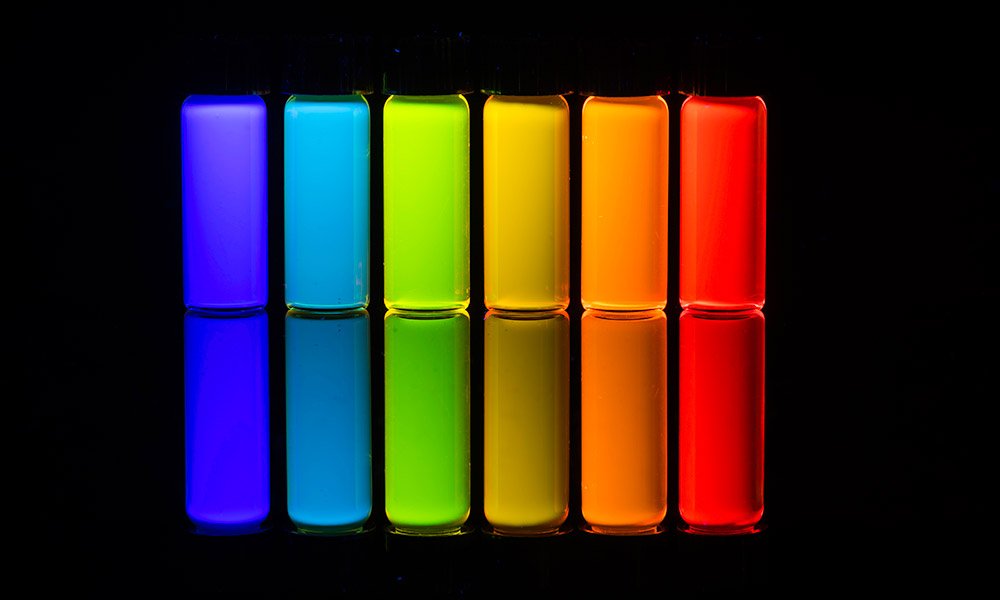
Quantum Dot Synthesis
Objective: Cadmium Selenium (CdSe) quantum dot synthesis was performed to demonstrate the effects of reaction time on properties of the quantum dots. This was done because of the reaction times relationship with creating dots of various sizes.
Background: Quantum dots are currently used in applications such as solar cells, biological imaging, and displays. They are important because of their property of quantum confinement, which is associated with a size-dependent band gap of the nanocrystals. This band gap is then able to be potentially controlled, which allows for us to change the attributes of a material to best fit our technology.
Setup and Procedures: Selenium (Se) precursors were prepared for our group through the dissolution of Se solid in 1-octadecene. This precursor was added to a solution of cadmium (II) oxide (CdO), oleic acid, and 1-octadecene at a temperature of 225°C. Samples of the created solution were taken from our reaction apparatus (a flask, water outlet, and reflux column) after 8, 25, 48, 90, 120, 240, and 480 seconds. These were put into cuvettes for UV-Vis spectroscopy. Finally, UV-Vis spectroscopy analysis was performed on these samples.
Analysis and Discussion: Figure 1 plots each sample’s ability to absorb and emit light at certain wavelengths.
Figure 1. The (A) absorbance and (B) emission spectra of CdSe quantum dots after varied reaction times.
For the absorbance spectrum of the CdSe quantum dots, we focus on the wavelengths between 520 and 640 because the rest of the plots’ steps do not yield much reaction-time dependent data. As examples, there is a large peak at around 260 nm, likely due to the octadecene blank first measured, and a step decrease at around 350 nm because of the switch from visible to ultraviolet light. The wavelengths around 500-580 represent the first absorbance decrease step, which generally increases as reaction time increases for each sample. For the emission spectrum, the same trend occurred (increased emission wavelength with increased reaction time). There are a couple of outliers, particularly with the absorbance for the 480 second sample and the emission peak of the 8 second sample. This could have been because there were insufficient amounts of the sample extracted during the synthesis for analysis in the cuvette. Qualitatively, the samples turned from a neon green to neon yellow as reaction time increased, which makes sense particularly as we compare the emission wavelength values. Table I summarizes quantitative properties of the samples based on their reaction times and emission/absorbance wavelengths.
Table I. CdSe Reaction Time and Quantum Dot Properties.
The diameter and bandgap of the CdSe dots were calculated using the wavelengths from the first absorbance peak. Because of this, there is a general increasing trend of the diameter as reaction time increases, but a decrease in band gap energy. This is expected as particle size increase is correlated with a decrease in energy shift in quantum confinement. As the quantum dots increase in size, the wavelength where light is absorbed similarly increases. We can leverage this as reaction time corresponds to an increase in size, and control the wavelength of absorbed/emitted light.
Conclusion: We could use our invariant of increased reaction time with increased wavelength to control the light absorbed into a new technology. For example, for use in quantum displays, we could use our knowledge of reaction times and emitted wavelengths to create red and green emitting quantum dots (for the red-green in RGB; unfortunately, blue is generally too difficult to create as the wavelength and thus quantum dot diameter is so small, so an LED might be used). Another application of the quantum dots could be to put layers in a solar cell such that they contain materials of many different band gaps, so they can take in a range of energies. This takes advantage of the fact that energy is best absorbed when it is exactly equal to the band gap. Overall, I believe that quantum dots, as a result of the properties allowed by quantum confinement, surely warrant further research to ensure maximal utility in new technologies.


